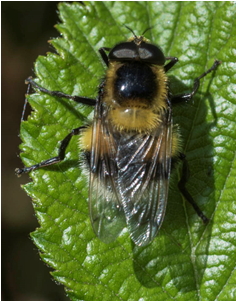
1st June – A rather warm day with a bright blue sky and temperature of about 27C. My walk in Richmond Park starts off well enough when I see lots of small mining bees and wasps (6-7mm in size or maybe slightly bigger) flying around a bare tree trunk with what appears to be lots of dart holes but which are actually the nesting holes of these Hymenoptera. The insects swarm all over the surface occasionally stopping and even more occasionally going into one of the small holes. I take a lot of photos of them, it is hard to focus because they are so small and fast moving, so maybe I can manage to get an ID or two but we shall see. There are somewhere between 40 and 50 insects at this site but it is hard to say because they just keep moving. I see four of these tree trunk nesting aggregations on the walk from Kingston to Ham Gate. An amazing sight that most people just do not notice. On one of the nest logs a single red-legged ichneumon wasp is seen rapidly walking across the surface of the wood and close to Ham Gate a single huge Hornet is spotted flying around a log, the first time I have seen one for a year or two. Another first is the bumble bee hoverfly mimic, Volucella bombylans with its distinctive plumose (feathery) antennae. Also found is another bumble bee mimic, the white tailed female of the hoverfly Eristalis intricaris.
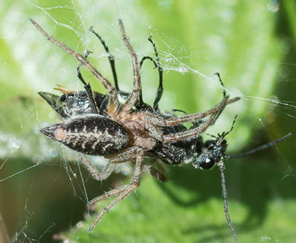
Brambles are coming into flower but there are relatively few insects around to take nectar from them. However there are lots of sheet spider webs amongst the Brambles and grass and I get lucky because on one of them is a spider with prey, it appears from the photos to be Agelena labyrinthica with its distinctive abdomen pattern and two large spinnerets clearly visible at the end of the abdomen. Trying to get closer disturbs the web and the spider drops to the ground before disappearing amongst the vegetation so I move on and around the ponds near Ham Gate there are some of the small blue damselflies flying and a Broad Bodied Chaser is seen near Latchmere Brook. White water lilies are coming into flower on the pond which is slightly up the hill from the gate, Ham Pan Pond, but there is nothing else really exciting although some Thistles are also coming into flower and some already have bees on them.
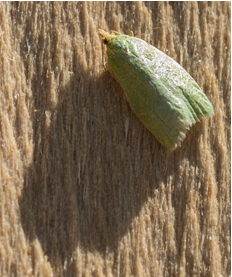
A bit further on there is a heavily cut up Willow tree and where the wood has been left exposed a piece of light green turns out not to be a leaf, as is my initial thought but a moth, the Green Oak Tortix (Tortix viridana). One blog reports this moth as being very common on the not so far away Wimbledon Common this week but I only see this singleton.
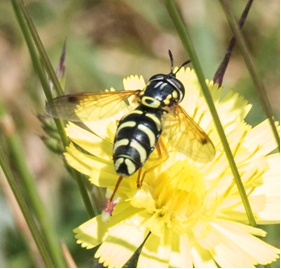
I walk up the hill and along the road that heads in the direction of the Penn Ponds before veering off across Slade Ponds towards the Ponds themselves. A Green Woodpecker is seen on an ant hill and it is my best (but non-photographable) view for some time of this bird which is wonderful and a bit further on closer to the Kestrel nest a Skylark takes off and starts to sing as it rises up in the sky. Next come some Stonechats, a lovely male sitting and singing from a bush and then a female also takes off so I guess they may be a breeding pair. I move on and there on a yellow Hawkweed there is a single hoverfly, a distinctive looking black and yellow one of the genus Chrysotoxum, and which is readily identified as C.festivum. The larva of this species feed on aphids which are found in ants nest so it is no real surprise to find one in the same area as the ant-feeding Green Woodpecker.
Above in the sky the female Kestrel is seen hovering and diving towards the ground several times but as she is not going back to the nest I can only assume she is either taking only small prey to eat herself or missing because if she has caught something worthwhile it will be taken back to the nest for the developing chicks. Other birds seen include a juvenile Jackdaw around the base of a tree trunk, a singing male Dunnock near Ham Gate, various Tits zooming around trees and a Song Thrush with its bill filled with food for its young.
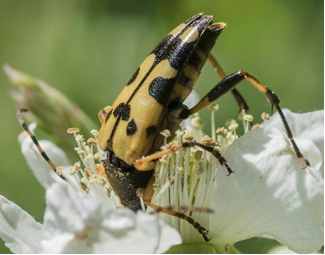
It is now round about 12:30 and is hot in the open so I decide to head for the King Charles Spinney path which is sheltered and it is indeed a lot cooler in there than out in the open. The Brambles just outside the gate are flowering and there are several bees, hoverflies, beetles and flies flying around and feeding on the nectar. A few are photographed including a Long-Horned Beetle, Strangalia maculata which is seen flying and then settling on a Bramble flower to feed. A few Scorpion flies (Pandora sp.) and a hoverfly of the genus Sphaerophoria are also around, the latter feeding on a Bramble flower. Of course Oedemera nobilis is still showing but the path itself proves very disappointing although a few interesting solitary wasps are seen, only one is photographed and hopefully when the Bramble flowers come out in greater numbers the insect safari will also improve…
Butterflies noted today include my first Small Skipper of the year near the same spot as the Chrysotoxum and a Red Admiral as well as the ubiquitous Speckled Wood. A couple of Meadow Browns are flying around the Bramble, another first for the year while the occasional White is also seen but not speciatated. A couple of moths are disturbed from the undergrowth but once again I cannot get photos of them so no IDs except for the two Nemophora degeerella, long-horned moths seen in King Charles Spinney. Overall what seems a not very good day at the time, the heat is a bit too much for me, yields some nice things!
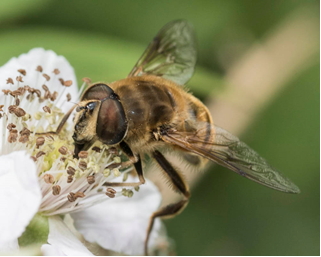
4th June – After a cloudy, chilly start, down to 10C the weather improves towards lunch time when the sun starts to break up the cloud and shines for an hour or two. A walk in the Park yields lots of bees, mainly Honey and various Bumble Bees taking nectar from Bramble flowers which are opening in their thousands if not millions. There are other insects seen on these flowers like solitary wasps, a few hoverflies (Syrphus sp, Eristalis tenax – male and female Eupeodes luniger and Marmalade Hoverfly in particular) and just the one Oedemera nobilis. There are not many butterflies on wing and only a few Small Heaths are disturbed when I walk around but there is a single male Large Skipper, wings open in typical fashion, trying to sun itself on a Bramble leaf.
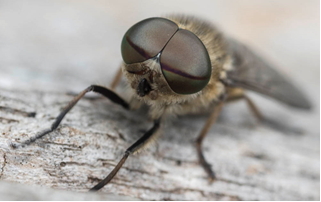
So far this year a couple of the insect groups I have not yet come across include the Horse and Robber-Flies but today that changes as I see at least two (and maybe three) species from these groups resting on logs or wooden fencing where I would expect to see them. I have been thinking they must be around and lo and behold they finally appear. One is the Horse-fly Tabanus bromius with the distinctive single red line clearly showing in the eye and the other is a Robber-fly of the genus Machimus which is slimmer and much hairier!
A wooden fence around a small piece of woodland proves quite productive yielding several small moths, Harlequin Ladybird adults, pupa and larva, several flies (including one of the Robber-flies), a small, dark solitary bee (or perhaps it was a wasp, most likely a Digger Wasp) and a Click-beetle that has a hairy abdomen so is the same Athous species I have been seeing in King Charles Spinney.
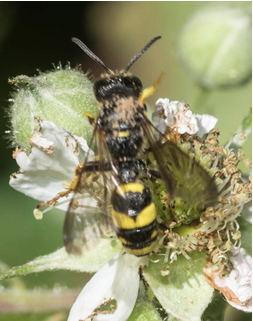
Nearby one patch of sandy path contains a three metre stretch with various size holes mined into it, accompanied by the small piles of earth surrounding the holes and a couple of different solitary wasps are seen hanging around them. Unfortunately by this time the cloud has returned so the sunshine has gone and I am guessing that is why the Hymenoptera activity on the site is so low. Maybe it will be better on another sunny day! One of the photographs is fortunate enough to show the wing venation pattern which allows the black and yellow one to be identified to genus level, Cerceris and the typical body marks to species C.arenaria.
I do not really look for birds today as my head is down and looking at the low Bramble which is proving more productive than originally envisaged, the initial plan is to go to Penn Ponds but I do not make it there. Not a bad day considering my initial aim is exercise rather than photography although taking the long and macro lenses does proves worthwhile despite my initial plan to only take the long one!
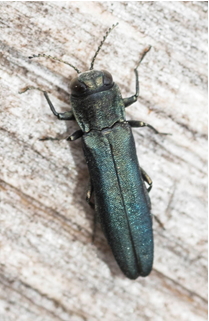
5th June – chilly day but with a few sunny spells, a strong cold wind and a few, light rain showers. Another early afternoon start and I go through Ladderstile Gate and across to the first block of woodland with flowering Brambles which is near Dann Pond. The sun is shining and there are bees, lots of Bumble Bees (white tailed mainly and of varying sizes) on the Bramble flowers, a few hoverflies and a single Long-Horned Beetle, Strangalia maculata. While I watch the first one a second Strangalia maculata lands on the flower adjacent to the first and then scrambles around and onto the same flower as the first before mounting it. All of a sudden there is a pair of mating Long-Horned Beetles right in front of me along with a 7-spot Ladybird. A good start to the afternoon but one that is not destined to get a lot better due to the changeable weather.
The wooden fence visited on 4th does not have anything new on it and by the time I reach the sandy, ground nesting wasp area once again the cloud has come over and the wasps seem happiest in their nest holes. However one or two are photographed and although most appear to black and yellow ones there is a single smaller, thinner one with a red patch on the abdomen which I hope to identify along with the others. Note the word hope for these insects are not always easily identified (unless I get lucky). Nearby while I am looking at the wasps there is a large herd of female Red Deer in the Bracken. A few solitary deer are also seen in taller Bracken, perhaps those about to give birth as it is that time of year. Two males with decent sets of velvet covered antlers are also spotted grazing away from the herd of females. However no Fallow Deer are visible today but I am not disappointed as I am not really looking out for them.
A second visit to the wooden fence after the second short and light rain shower, again does not yield much, with the exception of a dark blue-green, but rather black looking, beetle with an abdomen that looks long compared to the size of its thorax and head. My research shows this is a Jewel Beetle (family Buprestidae) of the genus Agrilus. On the way back to Kingston Gate a bird is flittering around a Bramble bush and calling from the top although there is also some noise from inside the bush so possibly there is a nest there. The bird is a lovely looking Whitethroat, the avian highlight of my afternoon walk.
After watching the Whitethroat for a few minutes it is time to go home so I walk towards Kingston Gate and passed the small pond where the grassy area is now looking very dry and the ant hills are standing out very well. A lot of them have plants such as the white flowered Lady’s Bedstraw and Mouse-ears but several have stands of yellow flowered Groundsel which have black areas on their stems. These are actually colonies of black aphids that are being tended by red ants and maybe as many as 20% of the stands of this plant are infested with aphids and their attendant ants.
6th June – there are clouds in the sky and the north wind is still blowing strongly but the sun is also still shining as I leave the flat at about 09:00. Unfortunately it clouds over and then the sun shines again but overall the cloud continues to build so it gets darker and colder and by 11 it is time to go home. However the first spot, near Dann Pond, I look at looks promising with several beetles, bees and various flies as well as a couple of hunting solitary wasps flying low to the ground but they do not stop and soon disappear when the cloud obscures the sun. Three heavily spotted black and red ladybirds turn out to be Harlequins once more and three shield bugs, Coreus marginatus with their diagnostic two small horns situated between the antennae are seen sitting on Bramble leaves. Also there is a brownish beetle with a red abdomen and two red spots on its rear end and from the really poor photographs it is possible to indentify this beetle as a Common Malachite Beetle (Malachius bipulstulatus). A Marmalade and a few other hoverflies including my first ever Syphrus torvus (readily separated from the other species in its genus because it has hairy eyes) are also found along with several butterflies; a male Large Skipper sunning itself on a Bramble leave, actually a couple are seen today, a Red Admiral flies by and finally there is a tatty looking Speckled Wood. It is a shame the weather takes a turn for the worse because surely this would be a really good spot when the sun remains shining.
Walking across to King Charles Spinney not much else is seen other than the various Bumble Bee species coming to the Bramble flowers but even they disappear after a while as the temperature drops. Yesterday they remained on wing even during the short rain showers but today they hide away. Reaching the Spinney I look at the Brambles on the outside of the path area but there are not many insects around other than the ubiquitous Bumble Bees. However a small patch of orange catches my eye and it turns out to be the red-eyed, orange bodied, Muscid fly, Phaonia pallida which I last saw about ten days ago in May, in fact there are several of them and along the path another one is seen but this one has a grey rather than orange abdomen so may is likely to be a different species although I could be looking at male and female of the same species but do not think this is the case from my reading around the subject. It took me some time to work out what the orange fly was and so I gained a little knowledge of orange bodied flies although I am certainly no expert!
Very little is seen along the Spinney path and despite being somewhat sheltered, it is still a few degrees colder than the surrounding area. The sun is covered by clouds apart from the occasional and very short lived sunny spell and so hardly any insects are out in the open. However overhead the mewing of a raptor can be heard and it does not really sound quiet right for a Buzzard and the bird turns out to be a Red Kite, although only seen in silhouette the distinctive shape of the tail is clearly visible. That is almost it for the Spinney (and my daily walk for today) but on top of a Bramble is what appears to be a bird dropping. However something tells me it is a moth rather than a bird dropping so I take several photos all the time wondering if it really is a moth because without using my reading glasses, which are in my flat, I cannot really tell. Poor photos are taken then I shake the Bramble and the “poo” remains firmly in place and so I start to think I was wrong and this is indeed a bird dropping after all but then it moves and flies away. It is a moth after all although it proves difficult even to get it to a genus. The final insect of the day is the day flying moth Nemophora degeerella, which is turning out to be the commonest moth I have come across in recent months.
Walking back it rains a little and so I am glad to get home after this short and rather chilly leg stretch! Unfortunately the next morning, at about 03:00 I feel a lump on my arm and find a tick is there. It is removed and the next morning two more are found on my ankle. I thought the socks would have protected my foot but I am proven wrong…
7th June starts with a little cloud but this clears leaving a warm and relatively sunny Sunday morning. It clouds up later, at round about 12:00 to 12:30 but initially it is warm although with a chilly wind blowing. A strange start to the walk once in the Park is seeing a Mallard drake sitting on the top of a cut-off tree. Now I have seen Mandarin ducks in trees but am surprised to spot a Mallard on the top of one even if it is cut off as I do not associate them with high perches such as trees! The sheltered Bramble bush spot near Dann Ponds which has been productive for the last few days is also productive this morning although mainly with the same insects. However on the first batch of Brambles there are a pair of Scorpion flies (Pandora species) with the male following the much larger female, he must be about two-thirds her size and clearly has the bright red “scorpion sting”, the male reproductive organ at the end of his abdomen that gives these flies their common name.
The Coreus Shield bugs are in the same spot, again there are three of them and there are also a couple of Large Skippers sunning themselves, trying to warm up. This butterfly is relatively common across the whole Park today especially where there is Bramble. A Speckled Wood is seen sunning itself and a Small Tortoiseshell is disturbed, flying off and then landing amongst some Bracken but a close enough view to work out what it is. The best butterfly sighting is later on and is not an adult but a dispersing communal nest of Peacock caterpillars. These are seen on the edge of Penn Ponds and near some Thistles that are almost in flower.
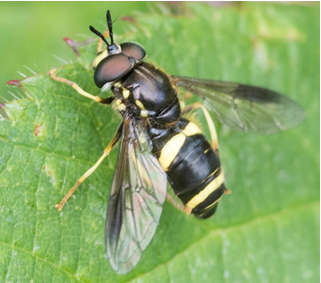
Bees are common again, although most are Bumbles with possibly a Cuckoo Bee (Psithyrus sp) and the solitary wasps continue to torment me by cruising around the Brambles looking for their prey but finally one stops on a flower and so I manage to get a photograph (or two…) which allows an identification to genus level, it is possibly another Cerceris species but is more likely to be the same one as before!
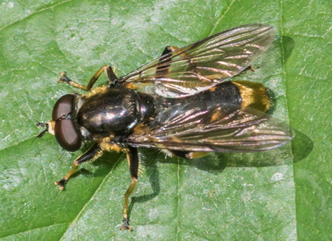
Perched out in the open on a Bramble leaf is what I initially think to be another solitary wasp but it turns out to be a Batesian wasp mimic, the hoverfly, the distinctive Chrysotoxum bicinctum, a species I know well from the nature reserve at Seaford Head in East Sussex so it is good to find this species on the edge of the grassy plain in front of Isabella Plantation. That is the second Chrysotoxum species in the last week and I also get to see my second Xylota species in King Charles Spinney. This one is larger than X.segnis and has a “golden tail” at the end of its mainly black abdomen rather than having a yellow abdomen. It is Xylota sylvarum another common species and another common species is Myaphora florea although overall this month it appears to be much scarcer than it was in May. Continuing the second species theme I identify a second Syrphus species which this time does not have hairy eyes but does have the mainly yellow hind femur and therefore turns out to be Syrphus vitripennis. The hoverfly lists continues to grow although slowly.
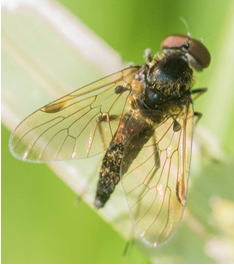
Having spent too long getting to Penn Ponds I walk past the Kestrel nest with its attendant horde of waiting photographers and continue along the side of the Ponds seeing a Blackbird and chick and the Sand Martins flying by. There is a single Common Tern that appears to be trying to protect one of the nesting rafts, which have been opened up, from the few gulls (Black Headed and Herring) that are flying over the Ponds. There is a Coot with a very young chick right by the side of the main path which goes between the two ponds. The adult bird tries to chase off dogs (on leads I hasten to add) that come close but the chick does not seem to move to maybe it is trapped although it does not seem to be in distress or panic. In the reeds by the path side, a very small and thin band of them, there are several damselfly species, Azure and Common Blue along with a single Chaser dragonfly which refuses to settle so remains un-identified and there is also a type of Snipe-Fly which poses for a while, Chrysopilus cristatus as it turns out. And just to surprise me a single male Reed Bunting flies in whilst I am talking to a woman about the Park and its wildlife.
Walking up from the Ponds to King Charles Spinney I there are several Red Deer and one of the females has a new born foal with her. They are however too far away to photograph but earlier and near to Isabella Plantation I did see a single female Red Deer with a young foal, spotted and much smaller than its mother. They disappeared into the Bracken and I lost sight of them. At the same spot adult Blue Tits were being chased by their young making a lot of noise in the process and there was also a Blackcap family disappearing into the Bracken before flying up into the trees and then flying away. People tell me of Great Spotted Woodpeckers feeding their chicks but unfortunately I fail to see, or hear, any. My only compensation is the number of Wrens calling from the Bracken and occasionally appearing on posts, the closest being only three metres or so away giving me a beautiful view of the singing bird.
By the time I reach King Charles Spinney the clouds are covering the sun for much of the time and so there are only a few sunny spells that occur every now and again. The insects are not fantastic but in one sheltered spot I find four Nemophora degeerella resting on the top of leaves and there is a new Shield Bug seen which turns out to be a Birch Shield Bug (Elasmostethus interstinctus). I just wished I had gotten there earlier but then again if I had I would have missed other things!
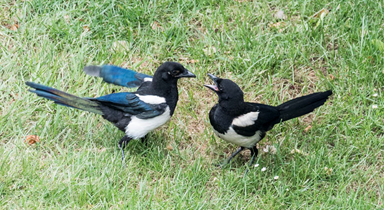
8th June – no morning walk but an observation from my flat window. Four Magpies are seen in the garden. Two are adult birds and the other two are young which seem to be enjoying the new found freedom of flying zoom around and across the lawn chasing after their partners and occasionally begging for food when one of the adults returns after disappearing for a while. One of the birds physically attacks another and they grapple claw to claw and with one on its back before they both fly off into a nearby tree. The juveniles which look to my eyes to be exactly the same as the adult birds appear to be able to search for their own food, chasing off the Grey Squirrels when they get to close but preferring to be fed by their parents where possible!
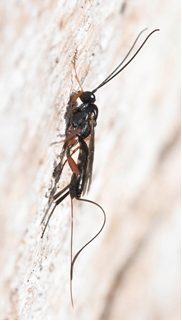
In the afternoon I decide to take a stroll despite the weather being a bit chilly and overcast. I walk from Kingston Gate to Ham Gate along the inside path, the Tamsin Trail, and then back along the road to Kingston Gate but there is not much insect activity, the hymenoptera nesting spots are empty apart from a number of the parasitic wasps, not necessarily Ichneumon wasps, and I hope they are something like Gasteruption jaculator, a parasitic species with a white tipped long gaster – the “stinger” part at the end of the abdomen which sheaths and protects the long ovipositor which the wasp uses to inject an egg into its prey within the tree! However further research shows in this case the insects seen are far more likely to be Ichneumon wasps rather than Gasteruption. It is an interesting observation that the parasitic wasps appear to be more active than their prey in the cooler weather. I notice this is the case on a number of occasions so it may be a genuine phenomenon but I am not 100% sure that is the case.
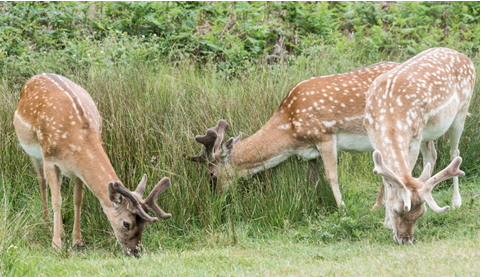
A small baby, buck rabbit is spotted near Ham Dip Pond and a juvenile Song Thrush is also seen in the open but it soon disappears into the Bracken. The only other notable natural history is three male Fallow Deer, all very nicely spotted, that are feeding on the edge of the road. They are not concerned in the least by the people passing by and their antlers are clearly showing but are encased in velvet.
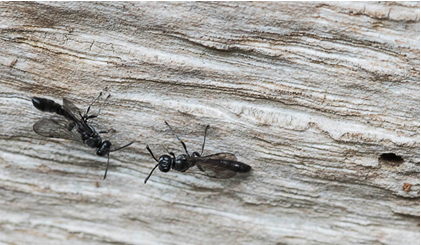
9th June – a warmer and sunnier day although there is some cloud but it is a better insect day than yesterday. Many insects are flying and the Hymenoptera nesting holes are all in full swing with lots of individuals flying around, disturbing or attacking those that try to perch, at least that is the case when the sun is shining. When the sun is hidden behind cloud the bees and wasps, I am certain there are at least two bee species and one, if not more of wasps, the latter having abdomens that are longer in relation to their wings, sticking out beyond the wings when landed and also the abdomen appears to be a lot slimmer than the bees which appear somewhat squatter and hairier in appearance. In flight and even on the poor photos it is possible to see the way the two fly is also different, the bees being almost rigid whereas the wasps are distinctly bent! Bumble and other bees are all over the Bramble and are more numerous than yesterday although even when it is a little chilly there are some still some flying and taking nectar.
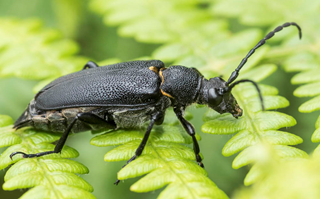
Back to today and there are various hoverflies on the Brambles but most elude being photographed although a Sphaerophoria sp poses nicely unlike the Helophilus and Syphrus which both fly off and so remain identified to genus only. An Empis fly is sitting very still on a leaf and in its mandibles it has another fly which is being devouring. The prey is a small fly, basically yellow but with some clear black marks on its thorax so may be identifiable! There are not many more insects although a large (c.20mm) black beetle allows itself to be photographed. It is a wonderful looking thing and it seems like someone has taken a hammer and small chisel to its surface causing pitting all over the abdomen and thorax! My first thoughts are it is a Long-horned beetle and so it turns out to be as it is the nationally rare Black Longhorn Beetle (Stictoleptura scutellata). There are also various flies and a few other insects such as Harlequin Ladybird larva which are seen near Ham Gate, a Large Red Damselfly seen flying in the wooded area, a Tabanus bromius seen on the same wooden fence as before and is therefore probably the same individual.
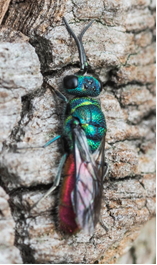
A Ruby-tailed Wasp (Chrysis species) is seen walking over a log but the spot with the ground nesting wasps is not very productive with only one black and yellow wasp seen, and not photographed probably because the sun has gone in. However I notice a small pink flower growing by the nest holes which turns out to be Sand Spurrey (Spergularia rubra), a genus of which I am familiar having seen several related species down on the south coast! When the sun is not shining the flowers remain closed.
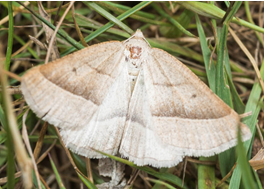
There are only a few butterflies around, a Red Admiral poses on a fence, a Small Tortoiseshell is disturbed from Bracken along with a Meadow Brown. Only a single Large Skipper is found today which is a surprise given how common this species has been over the last few days. There are also lots of a single species of geometer day-flying moth which I disturb in an area of Bracken near to the wooden fence on which the Tabanus sits. After a bit of a chase one of them settles, they are rather flighty most of the time, and so I get a photo. The moth is identified as a Brown Silver-line (Petrophora chlororata) and its larva feed on Bracken which fits in perfectly with the habitat in which I find them. After that it is time to go home for lunch!
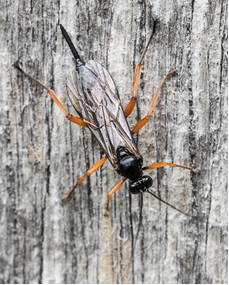
11th June – after a cloudy start and the rain that follows the weather improves with sunny spells in the afternoon so I decide to take a walk in the Park. On the way there and opposite the Albert pub a bird is singing loudly from the roof top and another is replying to its challenge on the other side of the road. It takes me a few moments but I home in on the singing and the bird turns out to be a Goldfinch. A wonderful bird to see and I have never noticed any in the area before although they have probably always been there. When I go into the Park at first the cloud means it is relatively cool but it soon warms up and I start to notice the wasps and bees in their normal nesting spots fluttering around but becoming still when the cloud comes over and then active again when the sun re-appears. The parasitic wasps are noticeable once more, running over tree trunks and logs with their feelers and wings almost constantly moving even when the legs are still. I take a few shots of the various Hymenoptera and move on. A large parasitic wasp lands on a wooden fence, it looks huge compared to the others I have been seeing and its legs are orange, it is an great view so I get a few shots and after checking the books I think it is a Pimpla, a species of Ichneumon wasp but there are several similar looking species so an ID to genus will have to do.
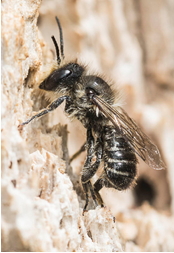
Cheered up by seeing something new I continue looking at the tree trunks, the old ones with their tops and often bark missing are best as these are where the nests of the Hymenoptera and other things are. Using the wing venation pattern as normal one of the bees photographed keys out to the genus Stelis but it does not look right when compared to the photos of the bees of that genus, all three of them. However looking on the next page of the book its identity is revealed, a Large Headed Resin Bee (Heriades truncorum) , a tree nesting species once rare in the UK but now apparently becoming more common in the Thames Valley area, especially in Surrey. Confidence is a wonderful thing but on 23rd June I see a bee which bring this conclusion and identification into doubt because that smaller bee looks a lot more like Large Headed Resin Bee (Heriades truncorum) than this one and is actually this species so the identification of the aforementioned Megachiladae bee remains unknown. Another bee found has a clearly marked abdomen and is a Colletes species, possibly C.similis although I would not sweat to this.
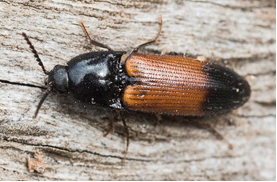
A Click-beetle, totally different to Athous, being smaller and more colourful, well actually bi-coloured black and orange is spotted as it runs across a log and disappears into one of the small round holes. This proves to be Ampedus balteatus a relative of the Cardinal Click-beetle, a Park speciality, which I have still not yet seen. At the same spot there is a long-horned beetle which means a bit of a clamber to get some shots of it. I think after checking the photos that this is a Black-clouded Longhorn Beetle (Leiopus nebulosus agg). On a nearby log there is fly which I try to approach but as I do so a large wasp lands on the bare wood and I am not surprise to identify this as a Hornet, another of the insects for which Richmond Park is renown.
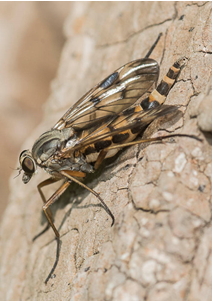
Despite a good look and wander not much else is found, the cloudy weather seems to make the insects disappear once more so I head across to the fenced area I had visited a few days ago. The Brown Silver-line moths appear to have all gone, yesterday’s rain probably did not help but there are six Tabanus bromius perching on the wooden fence and all well spaced apart, maybe they are also social distancing although I think there are probably more mundane reasons for them to be so separated. A few wasps are also seen including a rather black and drab looking Digger Wasp but they do not settle for long so I do not get any photographs. One other fly I get a good view of during the walk is a Snipe-Fly (Rhagio scolopacea) which poses nicely on a piece of wood but only two Machimus Robber-flies are seen, one with a prey item, another although unidentifiable small insect. The day turns out to be a bit better than I thought it would be but as it clouds over the time to go home comes and hopefully before the rain starts. The only real disappointment of today is the lack of hoverflies!
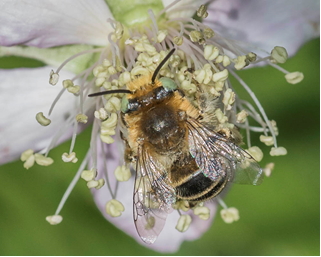
13th June starts a little cloudy and pretty humid after overnight rain. Still as the morning wears on the sun starts to shine and the insects start to appear in some places. In no particular order I will start with the Hymenoptera and the nesting holes are very busy this morning with the insects floating around but as excepted all settling when the cloud covers the sun. Several large black and yellow solitary wasps fly low around the Brambles and other vegetation but none settle at all, so no photographs. There is another Large Headed Resin Bee seen close too but on a different tree to the one that was seen the on 11th and there is a single Ashy Mining Bee in the same area. My photos also reveal that one of the bees has green eyes so is a bee that is easy to identify without to much difficulty for a change being a Green-eyed Flower Bee (Anthophora bimaculata). Only a few of the parasitic wasps including several Chrysis ruby-tailed wasps put in an appearance today but nothing that looks different or new to those previously seen.
In an area of Oak trees and Bracken where there is a sunlit spot with about twenty to thirty Nemophora degeerella dancing in the sunlight, appearing to float and down in an asynchronous aerial ballet, like little puppets on invisible strings and then all of a sudden they all stop and land on the Bramble leaves. Something I have heard and read about but never witnessed before so it is as an amazing experience to see such a display by these moths. They repeat the performance several times and some nearby some Soft Rush (Juncus effusus) is back-lit so I take a few shots just for the record. A couple of other small moths are also seen but nothing exciting except for an adult black and red Cinnabar moth on Ragwort, probably egg laying as this is the food plant for this moth’s caterpillars. Butterflies are not numerous and a single Small Tortoiseshell, Red Admiral, several Speckled Woods, Large Skippers, Large White and a Small Skipper (Thymelicus flavus) are the species recorded for today.
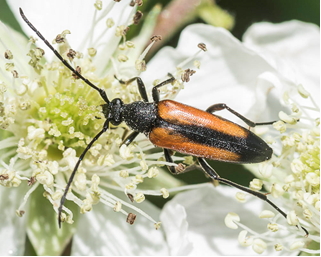
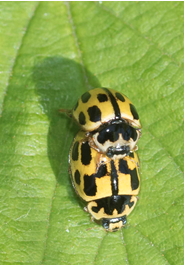
A few beetles are also seen and perhaps the pick of the few sighting is a pair of mating 14 Spot Ladybirds (Propylea 14-punctata) or maybe it was the black and red beetle feeding on Bramble, which I think is another species of Long-horned Beetle, and this beetle turns out to be a female Stenurella melanusa which is indeed a species of Long-horned Beetle as can be seen in the photograph.
Flies are as always visible, with both Robber and Horse-flies making appearances, the former sitting on a log bare of bark and with a small fly in its mouthparts, and today there are even some hoverflies seen including Xylota sylvarum, Eristalis sp, Helophilus sp and Syrphus sp.
The wooden fences only produce a couple of Horse-flies and King Charles Spinney is very quiet except for the bottom end where a patch of Bramble has the mating 14-Spot Ladybirds and the Small Skipper previously mentioned. The Bramble at the other end and outside the fenced Spinney area yields some other insects including a Conopid Fly (probably Myopa testacea again). None of the areas prove to be very good today so overall despite a couple of new things not a great return on a four hour stint in the Park!
To complete the story of the day round about 19:45 hours the dark, grey rain laden clouds start to build and just after 20:00 hours there are lightning flashes coupled with several really loud, rumbling thunderclaps which are probably the loudest I have heard, certainly as a group, in the UK for many years. I have heard just as loud if not louder one off thunder claps before but certainly not the three or four I heard this night. Initially the one second between the flash and thunder rule implies the centre of the storm is two or three miles away but this changes quickly and then about ten minutes later there is a short spell of very heavy rain before the storms move on.
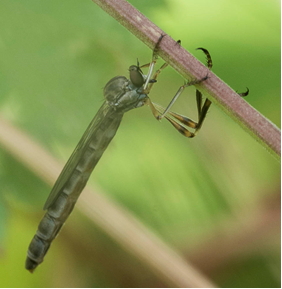
Sunday 14th June not surprisingly after yesterdays rain starts humid with some cloud and sunshine, and looks perfect for insects which it proves to be although by 10:30 the cloud builds up and shortly after it is time to go home. I spend almost an hour looking at the 10-15 metre patch of Bramble near to Dann Ponds and the insects keep on coming unlike the previous few days. As expected several species of flies are around and these include a Robber-fly (Machimus sp), another Robber-fly, one of the thin body ones although slightly obscured in the photo which looks like a Leptogaster species probably L.guttiventris, a female Scorpion-Fly, a Horse-fly (Tabanus bromius again) and yet another Conopid fly (same species once more).
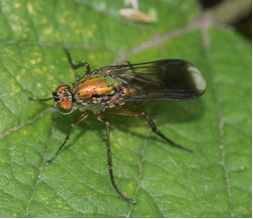
However one of the more unusual looking flies is small, has a metallic green body and black wings with white patches at the end. It does not like being photographed and takes off either as the shutter is clicked or the flash goes off virtually every time I take a photo but it is captured in one or two of the shots enabling it to be identified as a male Poecilobothrus nobilitatus, the females do not have the white at the end of the wings. This fly is associated with water so must be from the pond that is behind the metal fencing, trees and bushes.
Marmalade Hoverflies are perhaps the most common insect today followed by the Eristalis species, of which most individuals appear to be Eristalis pertinax, and there are several other hoverflies including Eupeodes luniger, Helophilus pendulus (more individuals seen than normal, with at least half a dozen seen), and a new hoverfly for the year, the relatively large, black and white but shiny Volucella pellucens – this is a species I often see in Isabella Plantation but not this year, at least not yet… A Chrysotoxum bicinctum lands on a Bramble leaf right by my side, a Xanthogramma with legs that are almost a luminous yellow is also seen on a Bramble leaf, Syrphus vitripennis and Sphaerophoria species visit the Bramble flowers in larger numbers than previously but nothing really special hoverfly wise appears.
There are a few beetles around (Strangalia again for sure), the ubiquitous O.nobilis and a few smaller ones which I cannot identify. Butterflies are not really showing well today with only a single Red Admiral making a fleeting appearance, a few Meadow Browns and that is it. There is a Cinnabar moth in the same spot as yesterday and there are few micro-moths but I do not hold out much hope of being able to identify them! Bees are still around but nothing stands out although on the other hand the solitary wasps are more numerous, there are several species, with different black and yellow markings and sizes. Better still they settle today allowing some shots to be taken which makes a change! One is certainly a Cerceris species and another appears to be a Gorytes, probably G.quadrifasciatus. A couple of Ruby-tailed Wasps are seen running over logs and tree trunks but they soon disappear as they always do; they never stay still for more than a few seconds at a time or so it seems to me. Strangely there are only a few Ichneumon wasps today but maybe that is because of the places I am looking, not too many Hymenoptera nesting sites are on my walk today.
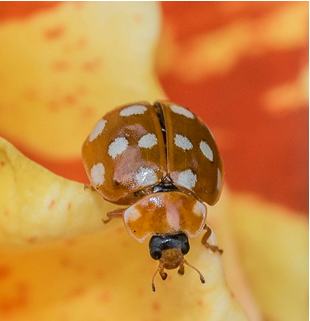
It has been a pretty good morning session before the sun disappears behind the clouds. The sun does shine a few times during the afternoon and so I visit the garden but there is nothing of interest with one exception. On a rose flower I find an unusual looking Ladybird, orange-brown with white spots, which my books tell me is a Cream-spot Ladybird (Calvia 14-guttata) another first for me! So it has proven well worth spending those few minutes checking the garden.
15th June is the first day of non-retail shops opening and Kingston Town centre is relatively quiet although there are long queues outside some shops. Noticing a long queue outside Fabric Land, a haberdashery shop, is a surprise but maybe people are after material and other stuff required to make their own face coverings! The weather is warm and sunny with few clouds in the sky although the cloud builds up round about lunch. As you may have deduced my walk today is not straight into Richmond Park but a walk from Norbiton station, after my coffee, into Kingston and then along the River Thames to Teddington Lock before coming back via Ham. The walk yields a few birds, a pair of Red-Crested Pochard, “…wearing pink lipstick” to quote a passerby, a couple of Great Crested Grebes, a flotilla of Canada Geese on the river with some young amongst them and a couple of Black-backed Gulls (probably Lesser) at Teddington Lock. Most of the umbellifer flowers along the river’s edge are over and some of the non-native species such as Rose of Sharon are just coming into flower along with Purple Loosestrife, a yellow crucifer and some Hawkweeds. None seem to be attracting many insects, a few bees and that is about it. Even the patch of Hogweeds near to Teddington Lock, a species which normally attracts many insects do not have much on them, a few beetles, flies and that is about it. There is a purple flower that appears to be attracting about half a dozen small skippers but these have black ends to the underside of their antennae and are therefore actually Essex rather than Small Skippers, a first for the year! Meadow Browns are on wing and a Red Admiral makes a short appearance but they are the only other butterflies I see. Only one warm patch of sheltered Bramble has any numbers of insects but most are bees and the rest flit around not resting although there is a long-horn beetle, a Rose Chafer, the first of these for a few weeks, and a green Soldier-fly which is another Chloromyia species.
By lunch time I reach Richmond Park, actually the Kingston Gate and go for a short but unproductive wander. The only insects of any note apart from a single very tatty looking Comma are both long-horned beetles, yet another Strangalia perhaps the commonest beetle I am coming across this year and another species called Leptura rubra.
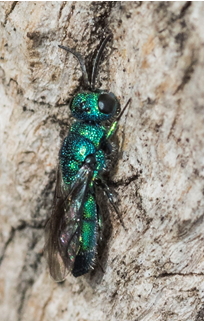
16th June starts off with sunshine but clouds over as the morning progresses and by lunch time there are only a few sunny spells occurring. Still my walk starts with not much happening but then as I move onto an internal path away from the main one around the edge of the Park after having entered via Kingston Gate I see what for me has become the holy grail of butterflies to be found in the Park. Although not rare Purple Hairstreaks spend most of their time in the oak tree canopy and only occasionally come down to ground level and there in front of me on a log with the wings wide open is a Purple Hairstreak. It heads back to the canopy before I can take a photo but I have finally found one after many, many years, the last time was in Southampton in 1986! A great start to my day and is followed by a visit to the various Hymenoptera “nesting” trees where on one there are two parasitic wasps, one appears to be an Ichneumon wasp, rather thin, flimsy looking and with some red colouration on the underside of the abdomen which supports a long ovi-positer, almost doubling the length of the wasp! However on reviewing the photos this wasp actually looks more like it is from another parasitic wasp family and is actually Gasteruption jaculator something I thought I had seen previously but which had turned out to be an Ichneumon so it is nice to get the to get it the other way around this time. The other wasp is a metallic looking and blue-green in colouration (with no red at all) which I think is a Ruby-tailed Wasp on first glance and although it turns out to be in the same family as the Chrysis wasps this cuckoo parasite is readily identified as another species, Trichrysis cyanea, which according to Chinery (2004) is one of our commonest cuckoo wasps and specialises in parasitizing small digger wasps.
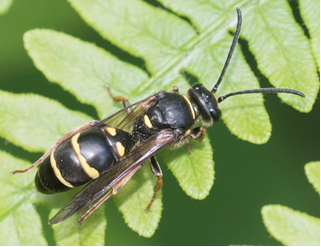
A passing couple tell me of a nearby Treecreeper nest with three chicks but although I stake out the tree, probably the wrong one as it happens, for a while but there is no sign of the birds although I do get to see the hoverfly Xanthogramma pedissequum, not quite a bonus but close enough and it is clearly this species because of the large size of the triangular wedges on tergites 2. Today it seems is all about quality rather than quantity because next up there is what I think is another solitary wasp which lands and then stays still allowing me to take photographs. Another exciting moment because this one is certainly not a Cerceris species, at least not one I have come across before because this one is bigger, more black with yellow markings rather than yellow with black markings which is the normal way I see them. It appears to be Argogortyes mystaceus which is a cleptoparastite of Nysson spinosus, another Solitary wasp I have not yet identified but must therefore be present as the clepto-parasites have specific hosts and can only reproduce if they are around. A couple of Strangalia beetles fly around the Bramble but refuse to land although another Volucella pelluscens hoverfly does land allowing for photos to be taken once more. The flight of the beetles is hard to describe but very distinctive once you have witnessed it.
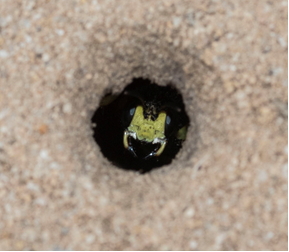
– Cerceris rybyensis
There is not much else on the Bramble that I notice so I head towards Isabella Plantation and walk around to one of the other entrances because I know there is a stretch of about 10-12 metres of path that has many, maybe 100 or more, holes that are solitary wasp nests. They are fresh holes too with piles of dirt heaped up around the varying size holes, the largest of which must be 7 or 8mm in diameter, and so they are much larger in the main than the 2mm “dart holes” found on the tree trunk nest sites (one or two of which are as active as yesterday today). There are at least three species of wasp nesting here going on the size of the individuals and the shape of the marking although the size difference could also be due to the difference between male and females, the females are bigger than the males. I think due to their size some individuals are likely to be the Bee-Killer Wasp (or Bee-Wolf), Philanthus triangulum because I photographed at this spot last year but none of the photographs prove to be of this species and it might still be a bit early for them. Most of individuals are certainly Cerceris species because I can clearly see the wing venation in the photographs. I can also see the face of the wasps in their nests as they peer out although when they notice me the wasps often retreat deeper into the nest.
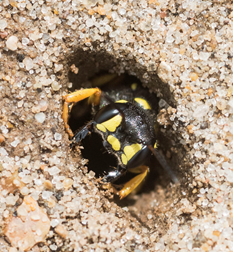
– Cerceris arenaria
When the sun is hidden by the clouds most of the wasps disappear but when it re-appears for more than a minute or so the number of wasps outside the nest rises once more. The most that can be seen at the same time is about 25 in the open although there are probably many more and the good thing about the face peering out of the holes is that they allow me to use the face pattern along with the body markings to speciate most of the wasps. There are Ornate Tailed Digger Wasps (Cerceris rybyensis) and Sand Tailed Digger Wasps (Cerceris arenaria) present and they are of course the two commonest and most widespread species of this genus!
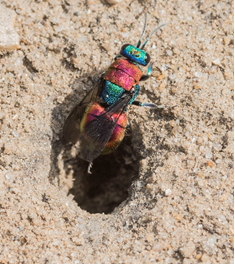
I also see what looks like a wasp with prey moving slowly over the sandy soil but what I am actually looking at is a female wasp being chased and harassed by at least three male bees, they all clasp together and the clump rolls over the ground. Eventually the two losing males move away to allow the other two to complete their mating. However this goes on for at least ten minutes so in the meantime I look around and spot what look initially like dark flies but on closer examination turn out to be what once again I think are brightly coloured metallic looking Ruby-tailed Wasps but not of the Chrysis genus for these, and there are about six of them, have a red rather than the blue/ green thorax of Chrysis so therefore are from the genus Hedychrum and given the solitary wasps are Cerceris species they are H.niemelia, a parasitoid on this genus of wasps. These are beautiful looking and multicoloured wasps when viewed close up with highly punctuated surfaces but they are cuckoo parasites and like the Chrysis Ruby-tails and the Nomada bees they lay their eggs in the nests of other hymenoptera where the developing larva will devour the host before becoming an adult. The Hedychrum are not actually Ruby-tail Wasps either but are called Jewel Wasps and they run around the nest holes popping into the vacant ones when they can and disappear of a short while before running out and continuing the search for more hosts. They fly around a little too but seem to spend most of the time on the ground.
After thirty minutes or so hanging around the same spot and sharing my knowledge of the wasps with passer-bys, some of whom seem genuinely interested, especially in the Jewel Wasps which I have been mistakenly referring to as Ruby-tails, it is time to move on and to go home as the cloud builds up and before the rain showers hit which they do at around 13:00 hours. One of the noticeable things during the morning whilst hanging around the Cerceris nesting site is the buzzing sound that can be heard, the sound of bees on the Bramble and probably louder here than other spots because of the proximately of Isabella Plantation with its myriad of currently inaccessible flowers, well at least to humans anyway.
However by 14:30 the sun is shining once more and the sky is blue so I take a chance and go out again this time going into the Park via Ladderstile Gate. The Dann Pond Bramble patches are quiet but there are two Cinnabar Moths flying around them although not much else so I head across to Isabella Plantation and the wasp nesting site once again. It is busy with wasps but nothing new appears and I try to take some more shots before the clouds come over once more before deciding it is time to go home but I am too late and it rains, lightly, before I even get out of the Park!
19th June once again starts grey and damp after more overnight rain but as the morning progresses the cloud and rain fade away to some extent and the sun eventually shines so in the afternoon I decide to go for a walk heading for the Isabella Plantation Cerceris nesting site. By this time the cloud is back and so few insects are flying but by about 15:30 the sun shines and the wasps start to fly again. Looking into the nest holes the faces on many wasps are visible, as if they are waiting for the sun to come so they can fly again. This gives me the opportunity to check the inhabitants and it seems that probably 90% are Sand Tailed Digger Wasp (Cerceris arenaria) and the others are the Ornate Tailed Digger Wasp (C. rybyensis). Only one H.niemelia is around but only when the sun is shining otherwise they seem to have all disappeared. A bit of a surprise given the weather conditions is to find a couple of pairs of mating wasps; one pair on a Dandelion and the other on a Bramble leaf, and both pairs are C. rybyensis. More of a surprise, and something that makes me jump, is when pointing the camera lens at a wasp nest hole not one but three C.arenaria in effect shoot out of it whilst one remains in the hole. It is quite an exciting moment because the three seem to be coming straight at me when they come out of the hole! Having seen many solitary wasps trying to enter holes that are already occupied and usually getting chased off, well always backing out and not entering at least, this really strikes me as something unusual to witness and I can only think they have either sheltered together from the rain or they have all just emerged as adults. A fascinating sight.
A couple of minutes later while the sun shines the temperature goes up and a small sheltered spot of Brambles seems to burst with insect life but only for a minute or two. A Large Skipper suns itself, two Ruby-tailed Wasps (Chrysis sp) come together, an Ichneumon wasp puts in an appearance along with a Marmalade Hoverfly, Myathorpa florea and a Xylota species (probably Xylota sylvarum) but after that all goes quiet as the clouds gather once more. Overall an hour and a half well spent and it is time to go home once more.
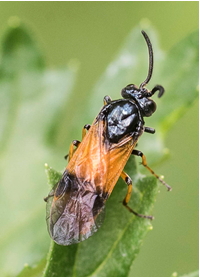
20th June – A bit of a theme this week with the poor weather first thing improving as the day progresses and often with sunny spells in the afternoon. Today is no different so I do not go to the Park until about 13:00 when the sun shines and when it does the temperature certainly goes up but the cloud means the sunny periods only last for five or ten minutes initially although as the afternoon goes on the sunny spells get longer and longer. My favoured Bramble patches are looking less promising than previously because the Bramble flowers are going over. Still there is a single red thoraxed Arge Sawfly resting on Ragwort, a black and orange wasp like insect which I think might be an Ichneumon but turns out to be a Sawfly (no pinched waist for starters) possibly a Aglaostigma species along with various bees and solitary wasps flying around along with a few flies, not many hoverflies although.
A single black and red Cinnabar moth shelters under a leaf and there are Large Skippers sunning themselves all over the place! Well certainly there are certainly a lot more Large Skippers throughout my walk from Dann Ponds to the Cerceris nesting site next to Isabella Plantation than there have been over the past few days.
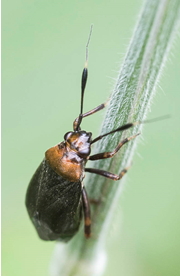
Settled on a grass stem is what I think initially is a small beetle but it is actually the black and brown capsid bug, Capsus ater with longish antennae which about half way along thin to the thickness of a hair. On the Brambles a female Scorpion-Fly with a small prey item sits and does not fly off like they usually do and there is also a pair of mating Coreus Shield Bugs a bit further on. It makes a change to seem them actually doing something rather than just sitting on a leaf. There is also an Eristalis pertinax using its proboscis on a leaf and then it retracts the proboscis using its forelegs to clean the feeding organ.
As I move towards the nesting site I check logs and bare tree trunks but only seem to find flies today with the single wasp I do see flying off before I can get on it. On a wooden fence surrounding an old Oak tree there is a single social wasp scrapping off some of the wood for its own nesting material. There is also a Click-beetle on the fence this one is only the second Ampedus balteatus I have ever found! But at least it is an easy one to identify. On the Brambles just before I arrive at the Cerceris nests there is a resting Andrena bee and also a Chrysis Ruby-tail Wasp which stays still long enough to be photographed, these wasps as previously mentioned are nearly always on the move so it is a pleasant change to see one sitting still for more than mere moment.
When the sun shines the nesting site is busy with wasps but once it is covered with cloud the wasps go to ground again. Today there is nothing special at the site which after yesterday is a bit of a disappointment but not really surprising. There are however about half a dozen or so Jewel Wasps checking out the nesting holes and they look so splendid when the sunlit hits them. I hang around for a while but apart from telling a pair of couples about the wasps and their parasites there is nothing else to record from this site.
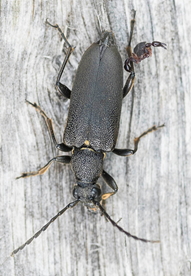
I decide to go home via Kingston Gate and so head towards the fenced area I first looked at on 4th June. It proves to be a good decision and there are a few insects resting on the wooden fence, plenty of Tabanus sp (and there are probably now two species because several individuals look larger than the T.bromius and have a different coloured eye pattern too). There are also about half a dozen Robber-flies, one devouring a small mirid bug and they tend to remain static while I photograph them although one or two decide not to have their picture taken and therefore fly away, usually not very far but just away from me! The Black Long-Horned Beetle seen on the 9th June is found again but this time on the other side of the enclosure and looking a bit less fresh than it did two weeks ago. I do not notice at the time but the beetle has a hitch-hiker attached to its left hind leg, a pseudo-scorpion about 2-3mm in size which appears in the photographs, a real surprise! This hitch-hiking behaviour is called phoresy and apparently does no damage to the host insect. It is not a parasitic behaviour but rather a means of dispersal. A look a last years photos revealed another case of this with the pseudo-scorpion being attached to a parasitic wasp’s leg.
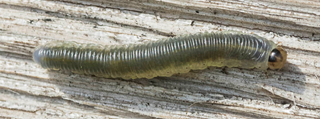
Two caterpillars walk across the wooden beams but I am not sure what they are and they are probably sawfly larva because they have a shiny surface which I do not associate with moth caterpillars and appear to have legs where moth caterpillars to not have them.
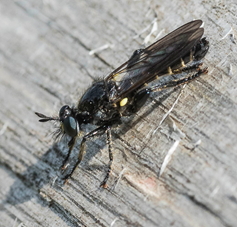
A potential pleasant surprise as not many have been seen since I started writing this diary is a Soldier-fly which sits on the fence. It does not like my attention and soon flies off which is a shame but I do get a photograph. It turns out that once again my initial thoughts are wrong and this is actually a Robber-fly, a Dioctria species I think incorrectly as it is turns out to be Choerades marginatus and so is not a soldier-fly at all. The usual red-eyed and black, chequered bodied Flesh Flies (Sacrophaga sp) are resting on the fence and sitting close by is another smaller, dumpier fly with golden hairs on its thorax enabling the identification of Cluster-fly (Pollenia rudis) to be made.
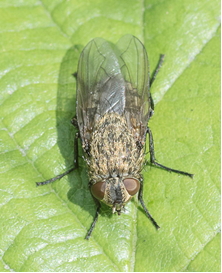
It is now time to head home, eye drops are needed and I had forgotten to bring them with me, so I head down the hill towards Kingston Gate and passed another mass of flowering Bramble. A large, orange butterfly comes out of the Bramble, I do not put it up this time, but it still flies off before I can get a good look at it. However there is no doubt it is a Fritillary but I cannot say if it was a Silver-Washed or Dark Green although my gut feeling having seen both species many times before is it is the former. A photograph would have been nice. A fine end to a decent and hot afternoon walk so I go home happy with what I have seen on my afternoon stroll.
Father’s Day, June 21st and the longest day of the year starts with overnight rain which clears up so the day becomes warm and humid although cloudy with sunny spells once more. The wind is also blowing quite strongly at times which makes photograph a bit hit and miss especially when trying to shoot insects on flowers. The first birds I see in the Park after going in through Ladderstile Gate are two pairs of Carrion Crows squawking at each other and then two of them start fighting. Feathers fly but as I get closer two of the birds fly off and the other pair fly up into a nearby tree. A less violent bird encounter follows with Whitethroats calling from the Bramble bushes before one appears on top of a bush. A nice but short view.
The area around Dann Ponds yields nothing new and the insect numbers are less than previous days but I still find a single Cerceris rybyensis and a bee which is a Colletes species, possibly C.similis but it could be C.fodiens as it seems to have the hairy face of the latter, both bees were taking nectar from a Bramble. There are both males and females of Eristalis pertinax on the Bramble flowers and a Robber-fly, in fact I see several today which are different to most of the ones I have been seeing over the last few days (with one exception). Once again these are from the genus Dioctria but which species is another matter as there are a several rather similar looking ones. Another first is what looks like a type of Snipe-fly species but which is clearly not Rhagio scolopacea because it has a different colouration, jizz and the wings are clear without any patterning at all and although it resembles this species my first reaction is this is likely to be another Rhagio species. However I am wrong and from the photograph it is a species from a different family, the Therevidae and turns out to be the species Thereva nobilitata. This fly was just resting on a log along with a Tabanus horse-fly but quickly flies off after my first few shots are taken.
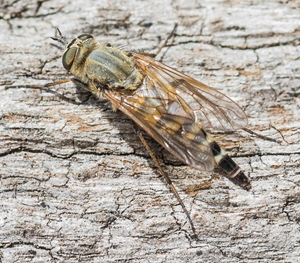
A few hoverflies including both Helophilus pendulus and Helophilus hybridus, male and female Eristalis sp, Sphaerophoria sp, Syrphus ribesii, Xylota sylvarum and Myathorpa florea are seen (and heard in the case of M.florea because the male certainly makes a distinctive high pitched whining sound when flying around).
Butterflies are not particular common today but Meadow Browns are perhaps the most frequent along with Large Skippers. There are a few Small Heaths, Large Whites and Speckled Woods but other than a Small Tortoiseshell this is it for the butterflies. Bumble Bees and other bee species are still flying around making a lot of buzzing noise. Also making a bit of noise on occasion are the grasshoppers most of which do not yet look full grown as they are pretty small in size although not as small as the black spotted, green bush crickets which are barely 5 mm long at present. Lots of these small green bush-crickets can be seen if you look closely at the Bramble and other leaves but not many people seem so inclined.
The King Charles Spinney path has a lot of Brambles in flower but there are not many insects because the sun has been obscured by the sun once more. I walk through the trees and only when I get to the bottom of the hill does the sun come out again and a few insects are seen, Tabanus and Robber-flies. I photograph the spider Pisuara mirabilis, a small moth and black aphids on a dock plant. The aphids are attended by ants who are taking the offered honey dew. Walking back up the path only yields a few more flies but it must be worth rechecking next week when the sun is meant to be shining all day and the temperature is going up to close to 30C. I spend some time looking at the Brambles around the entrance but there is nothing of interest there or on the walk back to Kingston Gate.
The 22nd June is a warmer day and the first time I have been out of the Kingston area for months because one of my camera sensors needs a clean, well both do but the camera with the macro on comes first, so I get a train to Vauxhall in order to visit Fixation. Wearing a face mask with glasses is not pleasant as my breath seems to be directed up and into my eyes. Still it has to be done to conform to the regulations and a pleasant surprise is to find WH Smiths open at New Malden (due to train times I had to wait for 20 minutes so went for a walk) allowing me to purchase a couple of magazines, the first for those over three months… After this I come back to the flat and get some water and replace my sandals with boots before heading into Richmond Park via Ladderstile Gate. Crossing the road once inside the Park there is a dead Silver Birch tree and perching on top is a Kestrel. It just sits there and ignores me and it is unfortunate I do not have my long lens with me. After walking on for a short while I talk to a couple who are surveying the Oak trees for the Oak Processionary moth, a bit of a plague in the Park these days as the moths have no natural predators at present. We have an interesting discussion although they do not mention the Oak trees infected with the moth have yellow discs placed on them, another couple told me about that yesterday.
I walk across towards the wooden fence area and a shadow moving over the ground catches my attention. It is the shadow of a large dragonfly which proceeds to float across the top of the low Bracken which is fresh here and bright green. The dragonfly turns and the sun lights it really well so the blue, slightly dropping abdomen and green thorax shine enabling an immediate identification. Without doubt this is a patrolling male Emperor dragonfly, Anax imperator and it looks magnificent as it flies over the brilliant green Bracken.
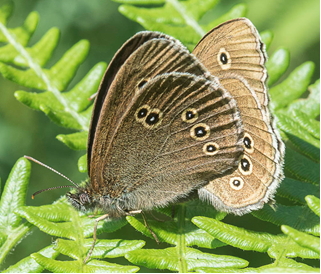
Still there are a few other insects around but not much else that is new with the exception of a mating pair of Ringlet butterflies which pose nicely and let me take a few shots of them. Whilst walking back I notice that some of what I am assuming, or have assumed, are Meadow Browns look dark in flight and I am sure I am seeing more Ringlets flying around although they fail to stop to allow me to check. Apart from getting a few better shots of a Dioctria Robber-fly, there are at least dozen species in the UK which require more knowledge than I have at present to ID to species level.
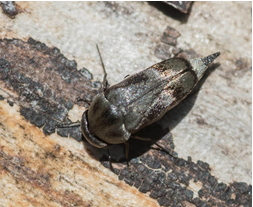
There is not much to photograph other than a mirid bug (identified as a Common Green Capsid – Lygocoris pabulinus) and a small beetle running over a log so I try taking some Oak leaf shots before heading home. The beetle has a very pointed abdomen which indicates it is a species of “Tumbling flower beetle”, they readily fall from flowers to escape any possible predator, of the family Mordellidae. Tomorrow, and the next three days the weather is going to be a lot warmer so maybe an earlier start will be a better idea!
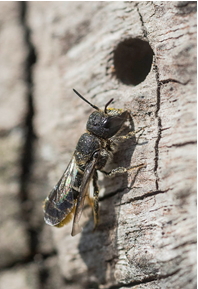
23rd June – a sunny, hot day. My walk in Canbury Gardens and along the River Thames does not yield much so I head home after an hour or so. An afternoon walk in Richmond Park and down to King Charles Spinney also yields very little mainly Honey and Bumble bees with the occasional, and compared to the rest of the week that should be very occasional, fly. One of the bees nesting in a fallen tree trunk has very orange, hairy underside and is probably a Megachile bee or if not that genus then certainly within that family and is possibly an Osmia or maybe this is actually the Large Headed Resin Bee (Heriades truncorum) rather than the one I thought was this species a few weeks ago! There is a splendid looking female Broad-bodied Chaser (Libellula depressa) beautifully lit on a Bramble stem and flying around in a couple of places there are several Common Blues and Marbled Whites and a single Xylota segnis is seen in King Charles Spinney so not a totally wasted day but maybe the high temperature, just over 30C has something to do with the lack of things to be seen.
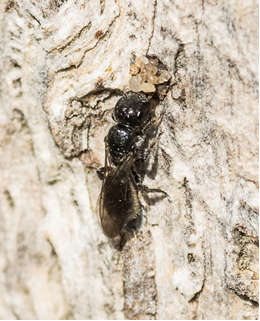
25th June is another really hot day so I go out earlier than normal and reach the Park way before 09:00 but it is pretty warm even now. The sun is shining and the sky is blue and the wasps around the nesting trees are active but only when the sun is on them and it seems that the time to seal nests has come because a number of the holes are now blocked up with grains of sand from the path. These wasps are probably from the genus Crossocerus if my identification is correct and my photos show that the wasps are using their jaws to place these grains, something intriguing to observe. The one thing I have not realised is how the sun will not be on the right spots by the time I reach them so the wasps and bees are not necessarily active. Even this early there are not many insects around other than the usual Honey and Bumble bees plus a single Gasteruption jaculator with the distinct white tipped gaster/ ovipositor. There are however at least two Megachile bees (or rather bees from that family) that are active, one is the same as the one I was on the 23rd with the golden-yellow underside and the other is bigger and what I think of as more Megachile like with its broad abdomen and fringe of hairs which are white this time and the underside of the abdomen is also white. Apart from these bees a few others of varying degrees of hairiness are also seen and photographed but none that really grabs my attention or interest other than the ones already mentioned. There are a couple of hoverflies (including Helophilus pendulus living up to the genus name of being sun loving), a few other flies and a couple of Strangalia maculata beetles with their distinctive flight where their body dangles under the wings. These beetles seem to get caught up every now again in some of the more feathery grasses as they fly around searching for a mate I assume, they seem to spend very little time at the Bramble flowers although they do appear to feed on them.
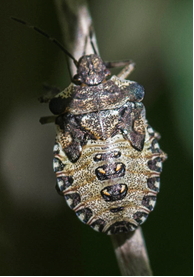
Today I take a detour and go out of Ham Gate and into Ham Common Woods which has a lot of flies flying around but not settling in most cases. It is cooler in the woodland but I do not really find anything of interest but it makes a change to be somewhere a little different. Walking back along the road towards Ham Gate I notice a harvestman on a grass flower head and so stop to take some photos of it as it has adopted a nice pose and is position quiet well, usually I find these hidden away rather than posing in the open! I also come across this Forest Shield Bug nymph.
So not a great day due to the heat but I do get to see some butterflies in reasonable quantities for a change, Meadow Browns are perhaps the commonest seen followed by the newly emerged Marbled Whites, a male Brimstone, Large Whites, Small White, Speckled Wood, Small Heaths, Thymelicus skippers, a Comma (on the edge of Ham Common) and a couple of Red Admirals. Nothing as special as the Purple Hairstreak but it is good to see so many butterflies on wing so to speak. No Common Blues today but I can also add Holly Blue, the summer brood appears to be on the wing now in the garden too.
Near to Ham Gate Pond I take some photos of flowering grasses as I have been meaning to do this for some time but never seem to get around to it! Today I do and when looking at some photos (and about to delete them because they were not that sharp) I notice what appears to be a green, small stick insect but on checking the books it appears this insect is actually a Hemipteran bug, a female (hence the green body) and of the species Notostira elongata. A nice surprise at the end of the day!
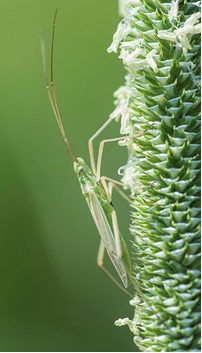
26th June starts out humid and continues that way with a lot of sunshine but also some cloud. It is warm and another earlier than normal start, by thirty minutes or so. This time I head through Kingston Gate and onto Ham Gate not stopping for much although some flies dancing around and on a small patch of water catch my attention, a bit of luck because they were gone when I came back at 12:30ish. I have seen one of these before because the metallic green body with blackish wings with white tips mean this is Poecilobothrus nobilitatus once more. I then continue to the pond at Ham Gate where I look for Notostira elongata and it does not take long to find one on the same type of grass as it was on yesterday. I find several more too (and another one on the way home about half way between Ham and Kingston Gates). This time I take a lot of photos of this species and also of a few other bugs and the flowering grasses as I need these shots to add to my stock agency photos, having none so far! What I do not notice whilst taking the N.elgonata shots are the two other capsid bugs which appear in the photographs, these both have two black dots on the thorax allowing them to be identified as Stenotus binotatus. Around the pond there are also Azure Damselflies and ovi-positing on the pond itself there are several dragonflies but they are too far away for me to identify. Meadow Browns are plentiful and so are the Thymelicus skippers but most are too flighty to get a good look at the underside of the antennae so they remain un-speciated.
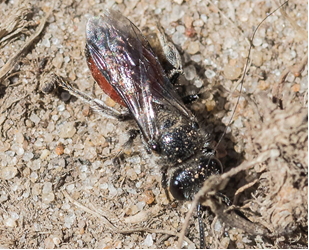
Having my fill of bugs I head out of the Park and into Ham Common Woods once more and which consists mainly of overgrown acid and heath grassland and so now is mainly woodland with a few open patches and some nice sunlit spots which support a number of insects. In the large open area I do not see many wasps and the two I do see appear to be Cerceris species once more but I also see some of the cuckoo Blood-Bees (Sphecodes sp.) that are flying low over the ground inspecting any nesting holes they manage to find. One enters but quickly comes out so I can only assume its wasp owner is at home and scares the bee off.
I see Strangalia maculata everywhere, never in large numbers but ones and twos on a lot of the Bramble patches, there are also hoverflies, Marmalade, a few Eristalis and Syrphus too and even a few of the smaller ones that refuse to settle in the open and so remain un-photographed. The black Dioctria Robber-flies appear today having been absent over the last few trips to the Park and one open patch has solitary wasp nests with large piles of earth and sand around some of these nests which look larger than most of the ones I have seen in the Park.
Only a few other butterflies apart from those mentioned above are seen outside of the Park, a Red Admiral and a Comma and inside on the way home a Common Blue is seen but there are no Marbled Whites or Brimstones today. A rather hot and sticky walk due to the humidity and the walk up Kingston Hill is airless as the wind that has been blowing every time I try to focus on an insect has now stopped blowing until I reach the entrance to High Ashton when starts up once more. It is cooler in the garden than in the flat as the afternoon progresses mainly due to the wind and round about 18:00 hours the clouds gather and it rains for a short while cooling the temperature to a much more pleasant level!
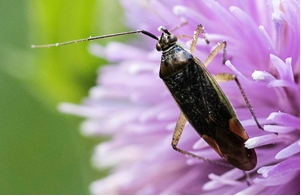
Sunday 27th June – a windy and cooler day than yesterday but there are some sunny spells so I decide to head to Ham Common thinking it might be a bit more sheltered than the Park and so it proves to be. The first little patch immediately to the right of Ham Gate yields some Thistles, Ox-eyed Daisy and Knapweed in flower and on the Thistle there is yet another type of mirid bug which I manage to photograph despite the wind and there are a few hoverflies and other insects there as well. There is a single Peacock caterpillar and there are several damselflies because the rather brown and mucky Latchmere Brook is there, and I identify Ischnura elegans and a Common Blue Damselfly (Enallagma cyathigerum) before moving on to the Common itself. There is a Dioctria Robber-fly posing nicely on a fern and then the cloud covers the sun for a short while so I walk on to the open area with the bee and wasp nests. There is little activity over the Gorse bushes although there are some prominent spider’s web amongst the stems, thorns and seed pods, the flowers are all over but nothing stops to be photographed so I concentrate on the nesting holes. Again there is little activity but I do photograph several bees, Blood-Bees are once more present and another darker looking species that has rather long, hairy pollen baskets on its hind legs and an almost shiny black thorax and abdomen. This appears to be the aptly named Large Shaggy Bee (Panurgus bankianus).
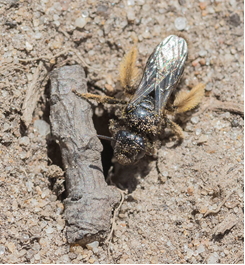
There are a few other hymenoptera around including some solitary wasps (certainly Cerceris species again) and one of the much large yellow and black spider hunting wasps which does not hang around to be photographed. By the side of the nesting holes some Oak trees are growing and they have branches that reach the ground which is a good indication there are no deer or ticks around! On some there are marble galls and artichoke galls on others, both of which are caused by gall wasps (Andricus kollari and A.fecundator respectively) while some leaves have common spangled galls caused by another gall wasp, this time Neuroterus quercusbaccarum and it is probably worth checking for other bangle galls caused by other species of this genus.
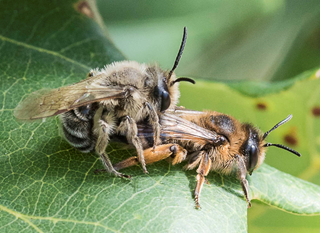
What is of more interest to me are the half a dozen or so greyish looking male bees that are flying over the low growing Oak branches and leaves. It seems they are searching for females because I see one suddenly stop flying and landing on a leaf where there is a female with which it immediately mates. They are probably an Andrena species but I am not sure as I do not have a good shot of the wing venation. I manage a few photos before the couple fly off.
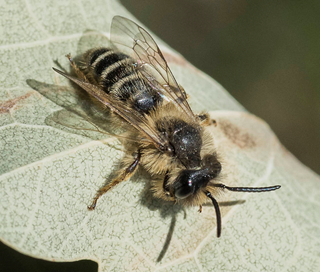
There is also another bee in the same vicinity which looks totally different to the hairy, grey, squat looking males. It appears at first glance to be an Andrena species but is much sleeker and clean lined than the other males just mentioned, a bit like a sports car compared to a white van which is probably a good comparison of the difference between them. However a second look at the photographs makes me think it more likely to be a Colletes species.
A few hoverflies, mainly black and Cheilosia like ones but with a couple of black and grey, red-eyed Platycherius albimanus, Myathophora florea, Eristalis species (mainly pertinax), Sphaerophoria and Marmalade hoverflies are seen along with several other flies including a second Dioctria feeding on a small aphid. The butterflies are not numerous with a couple of Red Admirals, Large Whites, Comma and a single perched skipper which this time is photographed although the wind blurred the shots and is identifiable as a Small Skipper (Thymelicus flavous).
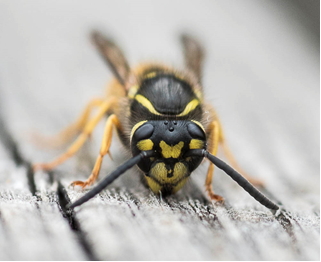
Re-entering the Park along with about one cyclist a minute despite the fact they should not be entering the Park at all, there is a sharp pain in my right big toe so I hobble over to a lump of concrete to sit and remove the offending grass seed which had penetrated my trainer and then my toe. The clouds are gathering quickly so it is time to head straight to Kingston Gate (a mile and 220 yards away according to the sign on the Park wall) which I do but still get caught in a light rain shower before the wind disperses the clouds once more and the sun shines again.
Overall a slightly more productive three and a half hours than first envisaged. I thought the wind would be a real problem but it turns out to be a nuisance rather than a show stopper and although a few shots were lost due to it I got more decent shots than I thought I would! An hour later the clouds come back and there is a short but relatively heavy shower so I am glad to be home before the rain comes.
29th June is another windy day with a lot of cloud but warmer sunny spells and getting up to about 21C. The wind makes photography difficult yet again but I decide to go to Ham Common once more mainly to try to get some more of the bees and the Oak galls after getting the second camera sensor cleaned at Fixation. A swift walk through the Park produces nothing but I am not really looking to see anything although I do notice that about half a dozen Poecilobothrus nobilitatus flies are still on the same spot of water by the last bridge between Kingston and Ham Gates. After this I move to the pond by Ham Gate and do a quick check for bugs but none are seen on the waving grass stems and flower heads but a dark blue leaf beetle is seen on an Alder leaf and a small, white bodied with black spots fly is also seen on the same tree. Checking the wooden fencing produces a wasp scraping off wood for the nest, it looks to be a Common Wasp (and there is a black, shiny insect larva (I have no idea what sort) walking across the wooden fence. It has three pairs of obvious legs at the front end and moves in a loop moth way, the back part forms the loops and the legged part moves forward. The process is then repeated as it goes forward. It may be a beetle larva but that is just a guess, although I am sure it is not a moth or sawfly caterpillar. There is also the same small whitish fly with black markings mentioned above but this time I can get an identification and it turns out to be Anthoymia pluvialis, a muscid fly.
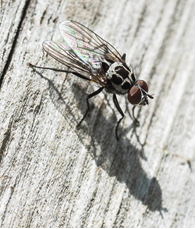
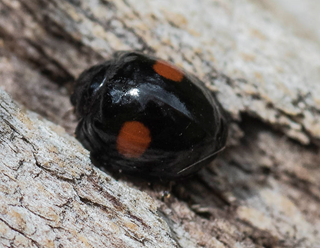
After that I move out of the Park and back to the spot just outside with its Thistles coming into flower, Ox-eyed Daisies, Knapweeds and other flowers including a couple of rather short Corn-cockle plants. It makes me wonder if garden waste has been dumped at this spot. Still it produces a new insect, a Kidney-spot Ladybird before I move onto Ham Common Woodland. There I spend about ninety minutes basically walking around and through parts of the whole woodland. There are a few sheltered, sunny spots with Brambles and a few umbellifers in flower and these yield some insects although other areas are darker being in shade and I find nothing. In no particular order there is a single Green-Veined White, a Comma, Small Skipper, Meadow Browns and a couple of Red Admirals flying around, settling for a few moments before flying off once more. Bees are not much different to previous visits in fact I see less, both species and maybe even in total number but there are flies which is good. Most are the Flesh-flies and Greenbottles but there are some hoverflies Eristalis sp in the main with some Myathorpa florea, Helophilus sp and a few Marmalade Hoverflies along with a few others which are unidentified. A couple of Dioctria both with prey are seen and there are also a couple of Conopid flies which again appear at first glance to be Myopa, the first I have come across for some time and making this year my best ever by far for this group of flies but the photos show this to be another species this time Sicus ferruginus (and makes me wonder if some of the others were this species too but re-checking the earlier photographs show I did indeed have the Myopa as well). At one point I notice something floating passed me and landing on the sandy soil. A close look shows it is my second Thereva nobilitata fly of the year (and actually only my second ever!).
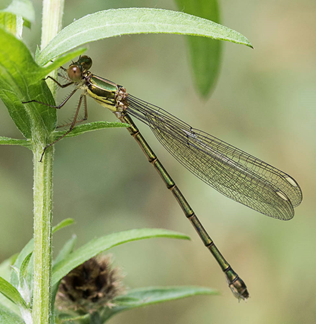
Another new insect for the year is a Soldier-beetle which is sitting on a Thistle flower. Although I have seen a Soldier-Beetle this year it was not this species which is the rather common Rhagonycha fulva and now it is on wing I expect to see a lot more of this species over the next few weeks. This is back at the original site just outside the Park and there is also a Willow Emerald (Lestes viridis), a type of damselfly once rare in the UK but which is now spreading rapidly across the county. It is hard to photograph in the wind and one of maybe twenty shots can be classed as almost sharp… At one point my camera was on the Willow Emerald but the wind moved it over two feet away before it swung back again. I spend about ten minutes here before giving up and heading home via the Park and Kingston Gate. Conditions ware not easy except in those few sheltered spots and only if I get my timing perfect which I rarely do are the photos any good. Still not a bad way to spend three hours!
The last day of June is a wet one so I do not go out to photograph anything today instead going to Kingston to sort out some internet access and paying for my website!
And so ends the first three months of social isolation and we can only wonder how much longer restrictions will be applied to our lives. I also wonder what else will be found in my local area other the next month or so. Fingers crossed my finds will be as good as the first three months.
 Leave a comment about this comment
Leave a comment about this comment